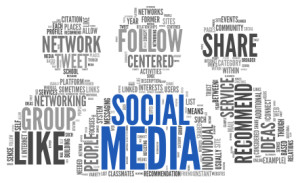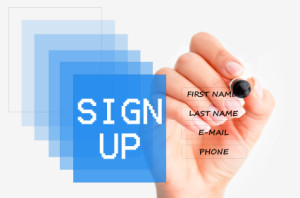by gabriel_sales | May 10, 2013
 It’s 2013, and it is safe to say that if your B2B company is not using social media as a marketing tool, you are behind. This is because many B2B companies (including your competitors) have realized the tremendous value in leveraging social media sites into their overall sales strategy. If for some reason your business has yet to join the social media world, this blog is meant to help introduce you to B2B social media marketing.
It’s 2013, and it is safe to say that if your B2B company is not using social media as a marketing tool, you are behind. This is because many B2B companies (including your competitors) have realized the tremendous value in leveraging social media sites into their overall sales strategy. If for some reason your business has yet to join the social media world, this blog is meant to help introduce you to B2B social media marketing.
In general, social media are websites and applications that allow users to create profiles, publish information and connect with friends and businesses. The users of these sites connect by ‘adding’ or ‘following’ one another. By adding or following someone or some company, you in effect ‘subscribe’ to all of the content they publish. The type of content published varies across the different social media platforms.
The largest and most predominant social media site today is Facebook. Facebook currently has 1.06 billion users and is mainly used by individuals to carry out digital, interpersonal relationships. However, businesses of all kinds have started to use Facebook as a way to help market their company, build their brand and connect with their customers in the digital space. Many B2B companies have recently discovered that most of their current customers and potential prospects are already on Facebook and have started to create Facebook-based marketing strategies to expand their reach. Using Facebook, B2B marketers can now push updates on new products, promotions or other activities to a large number of interested people, with a single click.
Twitter is another social media site B2B companies are using to build brand awareness and expand their reach. Twitter is similar to Facebook in that people ‘subscribe’ to your content by following you. Twitter differs in that the content published by users is in the structured form of a ‘tweet’. A tweet is a short message (140 characters max.) that can include short ideas, quotes, links to other pages, etc. In the B2B world, tweets are a great place to post industry trends, a problem you helped solve for one of your clients or even some simple ad copy. The one thing to remember with Twitter is your tweets should always stay on topic to things your followers are interested in.
The social media site most conducive to making B2B connections is LinkedIn. LinkedIn was designed explicitly for business professionals, meaning B2B people are already using it. This is now a place where B2B companies are making new connections with buyers and increasing their contacts.
Google+ is also becoming a major player in the social media world for B2B sales and marketing. With now two times the number of users as LinkedIn (400 million), Google+ may prove to be a major competitor to Facebook in the future. The value of this for B2B companies is that Google+ is more conducive to marketing than any of the other sites in that activity on Google+ is automated into its search engine.
If your B2B company has yet to take any action towards social media marketing, setting up profiles, finding followers and posting may seem like a daunting task. However, it helps to look at these social media sites as communities that you wish to join. Just like physical communities, once you start participating in digital communities, people starting interacting with you and relationships start to form. On the other hand, if your company simply puts up a profile and then does nothing with it, social media sites aren’t likely to produce marketing results. You need to remain constantly active on these sites, not just publishing your own content, but also interacting with the content posted by others. Used properly, these sites can easily translate into B2B lead generation and increased revenue.
For more information on leveraging social media as a marketing strategy for B2B sales, please reach out to us at Gabriel Sales. You can find our contact information here.
by gabriel_sales | Mar 23, 2013
 In the past few years, digital marketing has become the centerpiece of many B2B sales strategies. As a sales and marketing outsourcing company for B2B sales, we have found digital marketing to be quite effective for building brand awareness and generating leads. One of the best ways to leverage digital marketing is with the use of a company blog.
In the past few years, digital marketing has become the centerpiece of many B2B sales strategies. As a sales and marketing outsourcing company for B2B sales, we have found digital marketing to be quite effective for building brand awareness and generating leads. One of the best ways to leverage digital marketing is with the use of a company blog.
Blogs in the B2B sales world can be used as a platform for publicizing information about new products or services, promotions, etc. Informative or educational blogs can also be used to position yourself as an industry expert. If you can demonstrate expertise to your readers, your product or service starts to look much more appealing.
Blogs are also a great way to add a human quality to your business’s digital presence. In addition to information about new products or industry trends, you can use a blog to profile different employees or discuss a particular instance when your business solved a problem it was facing. This will help give your company a human aspect that is often lost online.
The key to achieving success in terms of B2B digital marketing with a blog is to make sure it remains active. This obviously takes more time, but constantly posting new and different information on your blog is well worth the effort. If you are able to consistently give your readers something of value, they will continue to come back and hopefully they will eventually reach out to you in some way.
While blogs are not necessarily considered social media, some of them can be thought of as online communities. There are many blogs that function as authorities in specific industries, which are often read by buyer’s who are looking for quality information in regards to making a purchase. If you are able to convince the blogging authority to endorse you in some way, you will likely attract a lot of leads.
It may be difficult to convince someone to advertise your product or service for you, but it is possible. Gaining the support of influential bloggers can be done by enticing him or her to write a review about you in exchange for a free product or service. However even if you cannot achieve this, any positive mention of your company is a good thing.
If you still need convincing that blogging can be an effective marketing tool for B2B sales, or would like help creating a corporate blog of your own, please feel free to contact us.
by gabriel_sales | Mar 18, 2013
 One of the best things about the internet today is its ability to support a variety of mediums for the spread of information. The internet is not only filled with plain text, but also has film and sound. Presenting your message in an auditory or visual format can help your B2B online marketing efforts reach more people in a more entertaining way through Interactive Marketing.
One of the best things about the internet today is its ability to support a variety of mediums for the spread of information. The internet is not only filled with plain text, but also has film and sound. Presenting your message in an auditory or visual format can help your B2B online marketing efforts reach more people in a more entertaining way through Interactive Marketing.
One way you can present your message using sound is with the use of a podcast. A podcast is a short audio broadcast that you can stream or download (from your website or a third-party provider), comparable to an online radio show. You can use podcasts to spread the word about your company and its products and/or services.
Video marketing is pretty self-explanatory; you present your message through an online video. Despite how it may appear, YouTube is not just for videos with cuddly kittens. Your B2B company can sign up for a YouTube channel, and you can use it to keep your viewers updated on industry-related trends or present a how-to or demo video about one of your products or services. Many B2B companies have yet to catch on to the value of video marketing, so this is one place where you may be able to gain advantage over your competition.
Another way B2B companies can use audio and video in their digital interactive marketing strategy is a webinar. A webinar is what it sounds like, a seminar that takes place on the web. For B2B companies, webinars can be used a sales conference or online meeting, which can be effective for building brand awareness, educating new prospects and improving demand generation.
For more information on leveraging audio, video and interactive marketing as a B2B online interactive marketing strategy for sales, please reach out to us at Gabriel Sales. You can find our contact information here.
by gabriel_sales | Feb 21, 2013
As a B2B sales outsourcing company, current industry trends may have you wondering what sales outsourcing and marketing outsourcing is and what it could do for you. Many businesses in recent years have found success hiring the best sales outsourcing company in developing a clear strategy and achieving business goals.

When considering whether or not outsourcing is right for you, it is important to know that no two sales outsourcing companies are the same. This means some companies are better than others at what they do, and you need to know how to spot the best sales outsourcing company.
Here are some basic tips to help you in your search for the best sales outsourcing company possible to fit your business’s needs.
Look for their achievements
You should first determine what they have done in the past. Go to their website or do other research to see if they have a list of successes or accomplishments. Look for their average ROI statement and ask if the same could be expected for your company.
Determine their specialty
Most sales and marketing outsourcing companies have a certain area of focus. Some outsourcing company’s expertise is with the high-tech industry, while some are best at telesales outsourcing or setting appointments. When looking for the best fit for your business, you should make sure the company has experience selling in the markets you sell to. You should also look to see whether they have experience working with the type of product or service you provide and whether or not they have found success working in your specific industry.
Find out how they recruit
It is important to understand how a sales and marketing outsourcing company recruits their sales people. This is because if the company uses a third-party recruiter, you will likely be paying for this sometimes quite expensive service. If you do not have unlimited funds for outsourcing, you may want to looking to a company that does their recruiting in-house.
Ascertain their training process
In B2B sales, most sales teams need a fair amount of training. If you are going to outsource, you want to make sure training is something provided by your outsourcing company. Look into whether or not the company provides this extra sales training to its sales reps and how it is executed.
Verify their success with evidence
During your search for an outsourcing company, you should ask for success stories or case studies. If they have at least several immediately available to you, it is probably a good sign. On the other hand, if you cannot find any positive remarks from past clients about a company, you can walk away with confidence.
While this list of tips for finding the best sales outsourcing company is not exhaustive, it is a good place to start. The most important part of finding a good fit for you is to establish the reputation of the company and qualify the specific ways the company can help you.
If you’d like to look into Gabriel Sales as a sales and marketing outsourcing option, please check out our services and client success stories, or contact us for more information.

by gabriel_sales | Jan 16, 2013

Many B2B companies try so hard to generate more leads that they do not come up with a clear strategy for how to do so most efficiently and effectively. What these companies do not understand is that a successful campaign requires clearly defined goals and a well-articulated strategy.
This blog is meant to educate those with less experience in B2B sales and marketing about the fundamentals of lead generation. Specifically, we will address the difference between soft vs. hard lead generation for B2B sales and when each is most appropriate to use.
(If you would like information with a little more depth, please visit our knowledge center focused on B2B Demand Generation.)
The first step in creating a strategy for B2B lead generation is to formulate your overall goals. You should ask the following questions:
• Who are you trying to target?
• What is the number of leads you want to generate?
• What do you want to achieve in terms of sales?
• Are you willing to pay for a lead? How much?
• Where do you want your leads to be in the sales cycle?
The answers to these questions become essential in determining which lead generation technique will be most effective for your business. Depending on what your goals are, you will usually choose either a soft or a hard lead generation strategy. Hard techniques usually generate a higher quality lead, while soft strategies tend to produce large numbers.
The soft offer:
Using an incentive with an apparently low risk factor, soft strategies will give you huge numbers of leads. For example, if you offer free tickets to the World Series, you are likely to get a massive number of responses. The downside of the soft lead, however, is that most of these respondents are more excited about baseball than learning about your business. So, while the soft lead may give you the numbers you want, most leads generated in this way do not progress any further in the sales cycle.
However, in our experience as an outsourced sales and marketing company, we have found that offering an iPad or a gift card can be quite effective, especially in terms of generating a quick opt-in database. We have also seen that the soft lead generation strategy is most effective for businesses trying to target leads early in their sales cycle. This method will take much more time because of having to sift through large numbers and so should be used primarily when attempting to generate activity or jump-start your sales.
The hard offer:
In a hard lead generation strategy, you offer something that is relatively higher risk than free tickets or an iPad. When you make this type of offer, which may require some type of commitment from your prospect, the leads you generate are usually going to be much further along in their sales cycle. Some things you can use as hard offer incentives are free consultations, preliminary audits, invites to webinars, etc.
When engaging with these types of leads, you should be aware they have a much greater chance of becoming closed deals. We have found that a hard lead generation method is most effective for businesses that have little time to weed through huge numbers of leads and are therefore looking to talk to leads much closer to making a purchase.
If you are still having trouble deciding between soft vs. hard lead generation for B2B sales, a good place to start is deciding who you are trying to target. If your goal is to reach marketing teams, a soft offer may be the most appropriate. On the other hand, if you are looking to speak to buying executives, you may want to go with the hard offer. Once you decide the kind of lead you desire and determine what will be of value to them, you will be able to come up with a successful strategy for generating leads.
Gabriel Sales has over 12 years of experience as an outsourced B2B lead generation company. For more sales basics, please feel free to visit our Blogs on Sales and Content Basics.
by gabriel_sales | Jan 9, 2013
 Creating successful B2B marketing videos is not like creating a Hollywood blockbuster. The best technical production in the world will not get you anywhere if your content is irrelevant. They key to digital marketing with videos is to provide your customer with something they actually want to watch.
Creating successful B2B marketing videos is not like creating a Hollywood blockbuster. The best technical production in the world will not get you anywhere if your content is irrelevant. They key to digital marketing with videos is to provide your customer with something they actually want to watch.
Here are some ideas for the types of content you can put in your B2B marketing videos:
- Repurposed television commercials
- In-depth discussions about specific products or services
- Post-purchase information
- Case Studies
We have found the most effective videos for B2B sales to fit into one or more of the three following categories:
- Informative:
- Many B2B blogs are centered around giving your reader some type of information. What type of information you give and how you present it can vary, as long as it remains relevant to your reader. Some companies chose a more news-based format, with a prominent employee talking about industry related happenings. Others instead give in-depth discussions of the company or a specific product or service. The most important thing to remember with informative videos is that they must have content your reader wants.
- Educational:
- An educational video should aim to be instructive or to teach something to your viewer. Rather than giving out general industry information, you should teach your viewer in a ‘how to’ type format. Show your viewer, in a step-by-step style, how to do something that is relevant and helpful to them. This format is most useful when showing your customer how to use your product or service.
- Entertaining:
- While people are willing to be informed and educated about your company, they would much rather be entertained. This is why entertaining videos are usually the most viewed and are the most likely to go viral. However, what is entertaining to people is not easy to gauge. One person may be rolling on the floor laughing over what another finds offensive. While it is much easier to simply inform or educate, if you can successfully entertain, you will grab many more eyes.
What is common among these three formats is that each gives the viewer something they want. Your video should provide something of value to them because if it does not, what reason does your viewer have to watch or share what you have given them?
Once you have crafted your video using one or more of the above formats, you should download it to YouTube. You can create a channel on YouTube for your company, so that all of your videos are aggregated in one place and are easy to find. While there are other video sites you can use, YouTube will get you more views and visibility than any of them.
For more information on B2B marketing videos, please reach out to us at Gabriel Sales. You can find our contact information here.
 It’s 2013, and it is safe to say that if your B2B company is not using social media as a marketing tool, you are behind. This is because many B2B companies (including your competitors) have realized the tremendous value in leveraging social media sites into their overall sales strategy. If for some reason your business has yet to join the social media world, this blog is meant to help introduce you to B2B social media marketing.
It’s 2013, and it is safe to say that if your B2B company is not using social media as a marketing tool, you are behind. This is because many B2B companies (including your competitors) have realized the tremendous value in leveraging social media sites into their overall sales strategy. If for some reason your business has yet to join the social media world, this blog is meant to help introduce you to B2B social media marketing.
 In the past few years, digital marketing has become the centerpiece of many B2B sales strategies. As a sales and marketing outsourcing company for B2B sales, we have found digital marketing to be quite effective for building brand awareness and generating leads. One of the best ways to leverage digital marketing is with the use of a company blog.
In the past few years, digital marketing has become the centerpiece of many B2B sales strategies. As a sales and marketing outsourcing company for B2B sales, we have found digital marketing to be quite effective for building brand awareness and generating leads. One of the best ways to leverage digital marketing is with the use of a company blog. One of the best things about the internet today is its ability to support a variety of mediums for the spread of information. The internet is not only filled with plain text, but also has film and sound. Presenting your message in an auditory or visual format can help your B2B online marketing efforts reach more people in a more entertaining way through Interactive Marketing.
One of the best things about the internet today is its ability to support a variety of mediums for the spread of information. The internet is not only filled with plain text, but also has film and sound. Presenting your message in an auditory or visual format can help your B2B online marketing efforts reach more people in a more entertaining way through Interactive Marketing.


 Creating successful B2B marketing videos is not like creating a Hollywood blockbuster. The best technical production in the world will not get you anywhere if your content is irrelevant. They key to digital marketing with videos is to provide your customer with something they actually want to watch.
Creating successful B2B marketing videos is not like creating a Hollywood blockbuster. The best technical production in the world will not get you anywhere if your content is irrelevant. They key to digital marketing with videos is to provide your customer with something they actually want to watch.